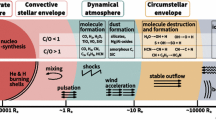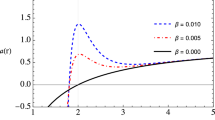Abstract
A simple model for the dynamics of stars located in a sphere with a radius of one-tenth of the central parsec, designed to enable estimation of the probability of capture in the close vicinity (r < 10−3 pc) of a supermassive black hole (SMBH) is presented. In the case of binary stars, such a capture with a high probability results in the formation of a hyper-velocity star. The population of stars in a sphere of radius <0.1 pc is calculated based on data for the Galactic rotation curve. To simulate the distortion of initially circular orbits of stars, these are subjected to a series of random shock encounters (“kicks”), whose net effect is to “push” these binary systems into the region of potential formation of hyper-velocity stars. The mean crossing time of the border of the close vicinity of the SMBH (r < 10−3 pc) by the stellar orbit can be used to estimate the probability that a binary system is captured, followed by the possible ejection of a hyper-velocity star.
Similar content being viewed by others
References
W. Brown, M. Geller, S. Kenyon, and J. Kutz, Astrophys. J. 622, 33 (2005).
W. Brown, M. Geller, and S. Kenyon, Astrophys. J. 787, 1 (2014).
W. Brown, M. Geller, and S. Kenyon, Astrophys. J. 751, 55 (2012).
W. Brown, J. Andersen, O. Gnedin, H. Bond, M. Geller, and S. Kenyon, Astrophys. J. 804, 49 (2015).
A. V. Tutukov and A. V. Fedorova, Astron. Rep. 53, 839 (2009).
H. Perets, Astrophys. J. 690, 795 (2009).
G. N. Dryomova, V. V. Dryomov and A. V. Tutukov, Astron. Rep. 58, 291 (2014).
G. Dryomova, V. Dryomov, and A. Tutukov, Baltic Astron. 24, 1 (2015).
G.N. Dryomova, V.V. Dryomov, V. V. Orlov, A. V. Tutukov, and K. S. Shirokova, Astron. Rep. 59, 1019 (2015).
J. Hills, Nature 331, 687 (1988).
J. Miralda-Escude and A. Gould, Astrophys. J. 545, 847 (2000).
Q. Yu and S. Tremaine, Astrophys. J. 599, 1129 (2003).
S. Gillesen, F. Eisenhauer, S. Tripple, T. Alexander, R. Genzel, F. Martins, and T. Ott, Astrophys. J. 692, 1075 (2009).
A. M. Ghez, S. Salim, N. N. Weinberg, J. R. Lu, T. Do, J. K. Dunn, K. Matthews, M. R. Morris, S. Yelda, E. E. Becklin, T. Kremenek, M. Milosavljevic, and J. Naiman, Astrophys. J. 689, 1044 (2008).
S. Gillessen, in Star Clusters across Cosmic Time (Fesenkov Astrophys. Inst., Almaty, 2013), p. 23.
A. M. Ghez, S. Salim, S. D. Hornstein, A. Tanner, J. R. Lu, M. Morris, E. E. Becklin, and G. Duchene, Astrophys. J. 620, 744 (2005).
F. Eisenhauer, R. Genzel, T. Alexander, R. Abuter, T. Paumard, T. Ott, A. Gilbert, S. Gillessen, M. Horrobin, S. Trippe, H. Bonnet, C. Dumas, N. Hubin, A. Kaufer, M. Kissler-Patig, et al., Astrophys. J. 628, 246 (2005).
Y. Sofue and V. Rubin, Ann. Rev. Astron. Astrophys. 39, 137 (2001).
A. Sesana, F. Haardt, and P. Madau, Astrophys. J. 660, 546 (2007).
R. M. O’Leary, and A. Loeb, Mon. Not. R. Astron. Soc. 383, 860 (2008).
Author information
Authors and Affiliations
Corresponding author
Additional information
Original Russian Text © G.N. Dremova, V.V. Dremov, A.V. Tutukov, 2016, published in Astronomicheskii Zhurnal, 2016, Vol. 93, No. 8, pp. 685–691.
Rights and permissions
About this article
Cite this article
Dremova, G.N., Dremov, V.V. & Tutukov, A.V. An estimate of the probability of capture of a binary star by a supermassive black hole. Astron. Rep. 60, 695–701 (2016). https://doi.org/10.1134/S1063772916070039
Received:
Accepted:
Published:
Issue Date:
DOI: https://doi.org/10.1134/S1063772916070039




